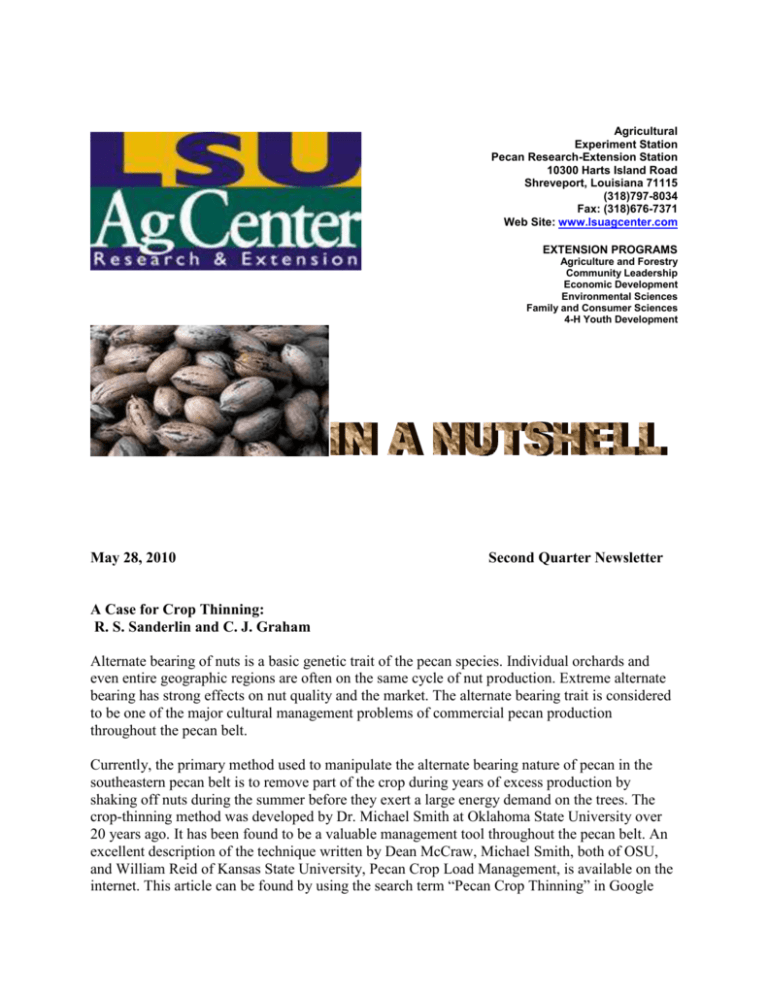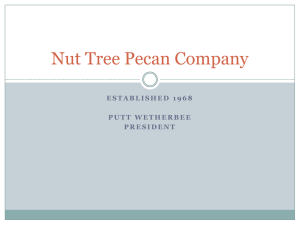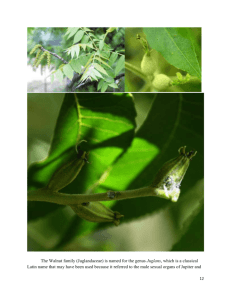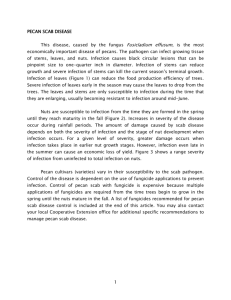In A Nutshell Second Quarter Newsletter
advertisement

Agricultural Experiment Station Pecan Research-Extension Station 10300 Harts Island Road Shreveport, Louisiana 71115 (318)797-8034 Fax: (318)676-7371 Web Site: www.lsuagcenter.com EXTENSION PROGRAMS Agriculture and Forestry Community Leadership Economic Development Environmental Sciences Family and Consumer Sciences 4-H Youth Development May 28, 2010 Second Quarter Newsletter A Case for Crop Thinning: R. S. Sanderlin and C. J. Graham Alternate bearing of nuts is a basic genetic trait of the pecan species. Individual orchards and even entire geographic regions are often on the same cycle of nut production. Extreme alternate bearing has strong effects on nut quality and the market. The alternate bearing trait is considered to be one of the major cultural management problems of commercial pecan production throughout the pecan belt. Currently, the primary method used to manipulate the alternate bearing nature of pecan in the southeastern pecan belt is to remove part of the crop during years of excess production by shaking off nuts during the summer before they exert a large energy demand on the trees. The crop-thinning method was developed by Dr. Michael Smith at Oklahoma State University over 20 years ago. It has been found to be a valuable management tool throughout the pecan belt. An excellent description of the technique written by Dean McCraw, Michael Smith, both of OSU, and William Reid of Kansas State University, Pecan Crop Load Management, is available on the internet. This article can be found by using the search term “Pecan Crop Thinning” in Google along with other articles on the subject. Briefly, the technique involves reducing the number of nuts in clusters by shaking trees with a mechanical tree shaker. This should be done shortly after kernel size reaches 50% to get the maximum benefit. For most pecan cultivars, this generally occurs in the latter half of July in Louisiana, but it can vary somewhat depending on seasonal temperature and rainfall. The growth size of the kernel can be judged by making longitudinal cuts from the base of the nut to the tip during the water stage and examining the kernel sac size relative to expected kernel size for the cultivar. The Pecan Station orchard over the past few years has been in an extreme alternate bearing situation. In 2007, the trees had a very large nut set and the intention was to apply the cropthinning procedure in late July to try to reduce stress on the trees and alleviate the extreme alternate bearing. However, July rainfall was over 11 inches and the orchards were too wet to use the shaker through the optimum window for shaking off nuts. Consequently, no crop was removed. The marketable yield of nuts in 2007 was 61 pounds per tree. This does not include the high volume of nuts discarded because they were below marketable grade, or the nuts not harvested because of low price late in the winter. True to the pecan alternate bearing trait, there was almost no crop in 2008. The per tree yield dropped to 7.5 pounds, with very few nuts not harvested. Just as in 2007, there was an excessive crop load in 2009. The plan was to thin the crop in the last few days of July. Over seven inches of rain during the last week of July resulted in the cropthinning procedure being delayed. Nevertheless, most cultivars were still within the proper stage of kernel expansion (between 50 and 100%) for crop-thinning. Orchards were shaken from August 12 to 14. At that time several cultivars, including Cape Fear, Kiowa, Gloria, Stuart, Moreland, Forkert, and Success, had about 75% kernel expansion. The cultivars Sumner, Curtis, and Melrose exhibited kernel sac size of 50 to 75%. The early maturing cultivars, such as Pawnee, Creek, and Candy, had completed kernel expansion and were in the kernel dough stage, too late to benefit from crop-thinning. The yield per tree in 2009 was 69 pounds, higher than in 2007, but with much less waste from non-marketable nuts. This spring there is circumstantial evidence of a positive effect of crop-thinning on return bloom and potential yield for 2010. One of the orchards with an excess crop load at the Pecan Station was essentially not shaken. The Cape Fear cultivar is present in this non-thinned orchard, as well as one of the thinned orchards. In the non-thinned orchard, Cape Fear had approximately 22% of the terminals with nuts in mid-May. In the orchard that was crop-thinned last summer, about 48% of the Cape Fear terminals have nuts. In addition to the Cape Fear in the crop-thinned orchard, two other cultivars are present, Stuart and Candy. The Stuart trees were shaken in August but Candy was not shaken because they were involved in another yield test. Like Cape Fear, the Stuart trees have the potential for a decent crop. On the other hand, there are almost no nuts on the Candy trees in this orchard. This was not a planned scientific comparison of the effects of crop-thinning and no doubt other factors are affecting the return nut set on the trees including a tree thinning operation done in the spring of 2008. Nonetheless, based on the observations described above, the overall crop potential for 2010 appears to have been positively influenced by the crop-thinning procedure conducted in 2009. Even though the procedure was two to three weeks later than optimum, some positive results have resulted. This technique does have some downsides. In spite of trying to keep the shaker flaps well lubricated, some bark damage did occur. The bark damage did not occur from excessively long shaking, but when bark came off trees; it slipped off instantly at the start of shaking. Crop-thinning is not equally effective on all cultivars, and it does not eliminate alternate bearing; even so, it can be useful for reducing extreme alternate bearing when orchards fall into that pattern. If alternate bearing is causing marketing problems for your orchard, you may find it helpful to consider crop-thinning. Information on this method is available on the LSU AgCenter Pecan Station website and other internet sources. Of course, you can always consult the faculty at the Pecan Station about using this procedure. Scab Potential: R. S. Sanderlin The lack of rainfall this spring has made it possible to delay the start of fungicide applications for prevention of scab disease and to increase intervals between applications. However, the lack of scab on leaves at this point in the season does not prevent the quick development of scab lesions on nuts. When the nuts are increasing at a relatively rapid rate in size (mid-June through July), they are most easily infected by the scab fungus during periods of rain. Watch weather forecasts carefully and protect the crop with well-timed fungicide applications if rain is predicted during this critical sizing period for the crop. Development of scab disease during this period can greatly reduce nut weight and result in loss revenue. One or two fungicide applications during the June through July nut growth period can easily determine the difference between profit and loss for the pecan production year. Refer to the first quarter newsletter to find information on appropriate fungicide choices for pecan scab control, the newsletters are available on the Pecan Station website. Pecan Spittlebug Michael J. Hall LSU AgCenter Pecan Research-Extension Station Description: The pecan spittlebug, Clastoptera acatina Germer, can be a serious pest of pecan in Louisiana. The adult is a pale brown colored insect, approximately 0.375 inches in length. The immature stages, or nymphs, resemble the adults, except that they are smaller and wingless. The nymphs are hidden with a white, frothy spittlemass, which serves to protect the nymphs from drying out. This spittlemass might also provide protection from natural enemies. Distribution: Pecan spittlebugs are found throughout the pecan producing regions of Louisiana. The severity of infestations varies from year-to-year and from orchard-to-orchard. Life Cycle: Pecan spittlebugs overwinter as eggs within slits in the bark of small twigs. These twigs are usually 0.5 inches or less in diameter. The nymphs become active in the spring and feed around the buds, current seasons shoot growth, and nutlets. In Louisiana, spittlemasses begin to appear shortly after bud break. The first adult spittlebugs usually appear about mid-May. Adults are difficult to spot because of their small size, inconspicuous coloration, and their tendency to jump when disturbed. Only the nymphs make the spittlemass and once the adults emerge the spittlemass dries up. The presence of dried spittlemasses on the trees is a good indication that adult emergence has occurred. Following the emergence of the overwintering generation, an additional two generations of pecan spittlebug occur each year. Type of Injury: Pecan spittlebugs feed on the water conducting tissue (xylem) of the plant. They have piercingsucking type mouthparts that they use for feeding on the plant sap. High infestation levels can cause terminal dieback, poor nut filling, and premature nut drop. Pecan spittlebugs are known transmitters of the bacteria, Xyllela fastidiosa Wells et al., that causes pecan bacterial leaf scorch (PBLS), a disease that can cause severe defoliation on cultivars susceptible to this disease. Control: Pecan spittlebugs are often kept under control when insecticide applications are made for control of other pecan insect pests. In the past, an insecticide application made specifically for control of pecan spittlebug has not been recommended. Because pecan spittlebug is an important transmitter of the pathogen that causes PBLS, control for pecan spittlebug should be considered if spittlemasses are found on 10 percent or more of either bearing or non-bearing terminals. It is important to control pecan spittlebugs before they reach the adult stage of development, as it is the adults that are capable of transmitting the pathogen that causes PBLS from tree to tree. When using insecticides be sure to adjust the pH of the water being used for spraying to 5.5 to 6.5 to ensure maximum efficacy of the insecticide. For the insecticides to use and proper rates to apply, consult your county agent, or the Insect Pest Management Guide which can be found at www.lsuagcenter.com. A spiral bound hard copy is available for purchase through the LSU AgCenter Online Store at www.lsuagcenter.com/online store. LSU AgCenter Pecan Station Field Day May 20: About 45 people attended the Pecan Station Field Day, which began with a tour of the orchards and discussion of research projects by the faculty. Topics included nutritional research on a young orchard, the use of a growth regulator to reduce crop loss, the objectives of the Pecan Station breeding orchard and involvement of the Pecan Station in the USDA- NPACTS program discussed by Charles Graham. The entomological research program by Mike Hall included the importance of monitoring pecan weevil and pecan casebearer activity and new pecan phylloxera research. The result of crop-thinning conducted last summer was presented by Randy Sanderlin along with information about the potential of a different fungicide class for pecan scab control and trapping insect vectors of the bacterial leaf scorch pathogen. Unfortunately, the tour was terminated at the halfway point by a rain shower. The discussion of research projects and a discussion of air-blast sprayer calibration by Roberto Barbosa from the LSU AgCenter Biological and Agricultural Engineering Department were resumed inside. The program was concluded with a barbeque lunch and informal discussions among the faculty, LSU AgCenter administrators, and pecan producers. AgCenter Honors Ben Littlepage: Ben Littlepage was presented with a rare honor in being recognized by the LSU Agricultural Center Experiment Station and Cooperative Extension Service administration for his many years of dedicated service to the Louisiana pecan industry and his loyal support of the AgCenter’s Pecan Research-Extension Station. Littlepage was instrumental in having the ownership of the Pecan Station transferred to the LSU AgCenter and has maintained his support of the Station since the AgCenter took over operation of the station in 1974. Littlepage is shown receiving a plaque in recognition of his service during the Pecan Station Field Day, May 20 from Dr. Paul Coreil, vice-chancellor and director of extension and Dr. David Boethel, vice-chancellor and director of research. Sincerely, Pecan Research-Extension Staff Randy S. Sanderlin- Pathology Mike Hall- Entomology Charlie Graham- Horticulture





